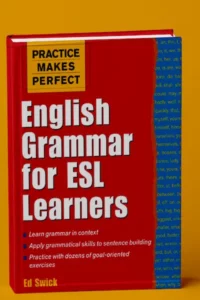English Grammar for ESL Learners features well-organized presentations, skill-building exercises, and a focus on practical conversational skills.
Here you will find clear explanations accompanied by highlighted examples and boxed summaries of key points. You also get numerous exercises in a variety of formats, including fill-in-the-blank sentences and passages, translations, multiple-choice questions, sentence rewriting, and creative writing exercises. Answers to all questions are provided in the back of the book.
English Grammar for ESL Learners
Many people consider learning grammar a chore. And at times, it can be. But understanding the grammar of any language is essential for becoming a skilled and accurate user of that language. English is certainly no exception.
The rules of grammar for a language learner are like the rules of the road for a driver. In order to be able to drive properly and maneuver with other drivers, you have to know the rules that everyone goes by. Naturally, some people break the rules and make driving difficult for other drivers. This is true of language, too. If you follow the rules of grammar, you can express yourself clearly. But if you fail to observe those rules, people may find it difficult to understand you or they may even misunderstand you entirely. So it’s really very important to understand and use correct grammar.
But what is grammar? Funk and Wagnalls’s New College Standard Dictionary describes grammar as “a type of science that explains the various principles of oral or written usage of a particular language.” It is also said to be “the developed art of speaking or writing accurately in a particular language.” Whether science or art, grammar is made up of the descriptions that tell you how to use a language correctly. For example:
Description: Begin a sentence with do to change a statement to a question.
Usage:
- Statement = “You understand the problem.”
- Question = “Do you understand the problem?”
Or:
Description: Use he as the subject of a sentence; use him as the direct object.
Usage:
- Subject = “He is a good friend of mine.”
- Direct Object = “I visit him very often.”
There are many such grammatical descriptions, and each one is a building block in the structure of your knowledge of how to form and use English correctly. The greater the number of building blocks that you master, the greater your accuracy with the spoken and written language will be.


